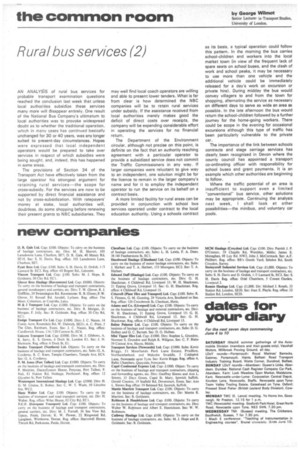Rural bus services (2)
Page 58

If you've noticed an error in this article please click here to report it so we can fix it.
AN ANALYSIS of rural bus services for probable transport examination questions reached the conclusion last week that unless local authorities subsidize these services many more will disappear entirely. One result of the National Bus Company's ultimatum to local authorities was to provoke widespread doubt as to whether the traditional operation, which in many cases has continued basically unchanged for 30 or 40 years, was any longer suited to present-day circumstances. Hopes were expressed that local independent operators would be prepared to take over services in respect of which subsidies were being sought, and, indeed, this has happened in some areas.
The provisions of Section 34 of the Transport Act have effectively taken from the large operator his strongest argument for retaining rural services--the scope for cross-subsidy. For the services are now to be supported by direct financial assistance and not by cross-subsidization. With ratepayers' money at stake, local authorities will, doubtless, do some shopping before renewing their present grants to NBC subsidiaries. They may well find local coach operators are willing and able to present lower tenders. What is far from clear is how determined the NBC companies will be to retain rural services under subsidy, If the assistance received from local authorities merely makes good the deficit of direct costs over receipts, the company will be expending considerable effort in operating the services for no financial return.
The Department of the Environment circular, although not precise on this point, is definite on the fact that an authority reaching agreement with a particular operator to provide a subsidized service does not commit the Traffic Commissioners in any way. If larger companies were reluctant to give way to an independent, one solution might be for the licence to remain in the larger company's name and for it to employ the independent operator to run the service on its behalf on a contract basis.
A more limited facility for rural areas can be provided in conjunction with school bus services operated under contract to the local education authority. Using a schools contract as its basis, a typical operation could follow this pattern. In the morning the bus carries school-children and workers into the local market town in view of the frequent lack of spare seats on school buses, and the clash of work and school peaks, it may be necessary to use more than one vehicle and the additional vehicle could be immediately released for a day's work on excursion or private hire). During midday the bus would convey villagers to and from the town for shopping, alternating the service as necessary on different days to serve as wide an area as possible. In the late afternoon the bus would return the school-children followed by a further journey for the home-going workers. There could be scope in the evening for occasional excursions although this type of traffic has been particularly vulnerable to the private car.
The importance of the link between schools contracts and stage carriage services has clearly been recognized in Devon where the county council has appointed a transport co-ordinating officer with responsibility for school buses and grant payments. It is an example which other authorities are beginning to follow.
Where the traffic potential of an area is insufficient to support even a limited -conventional" bus service, other solutions may be appropriate. Continuing the analysis next week, I shall look at other possibilities-the minibus, and voluntary car pools.
































































































